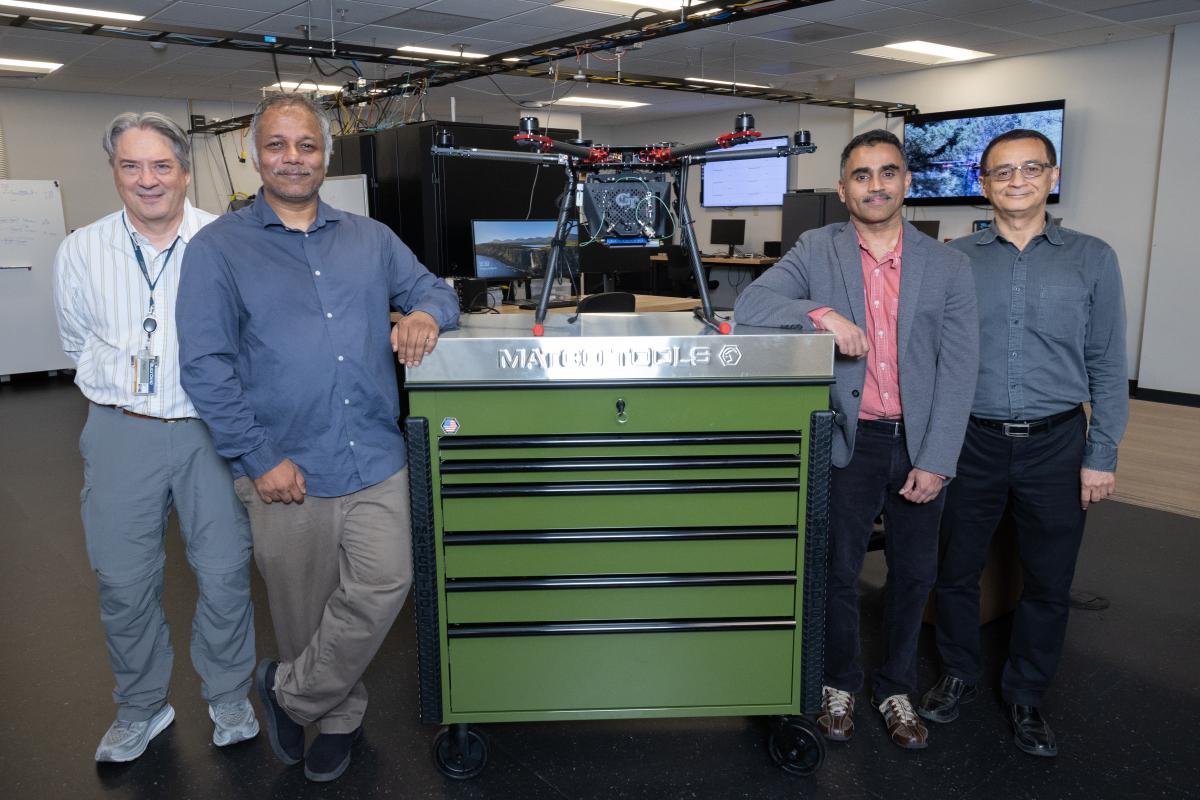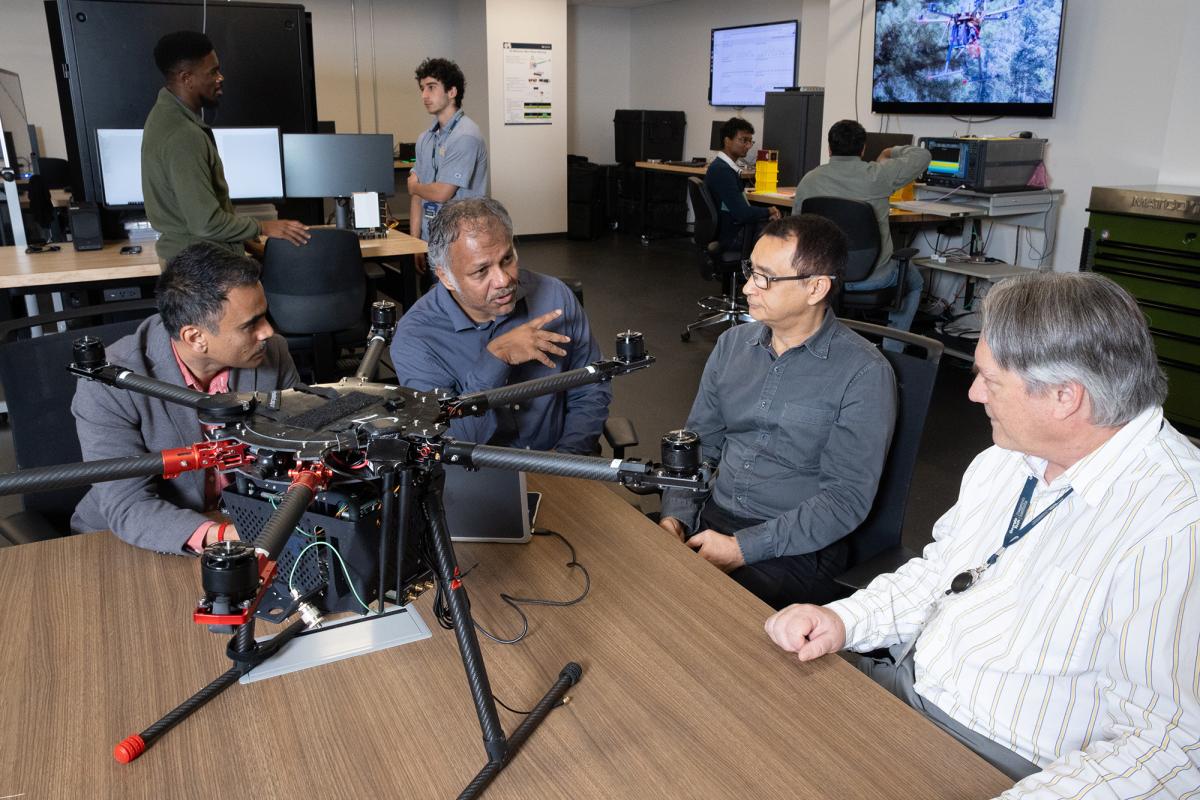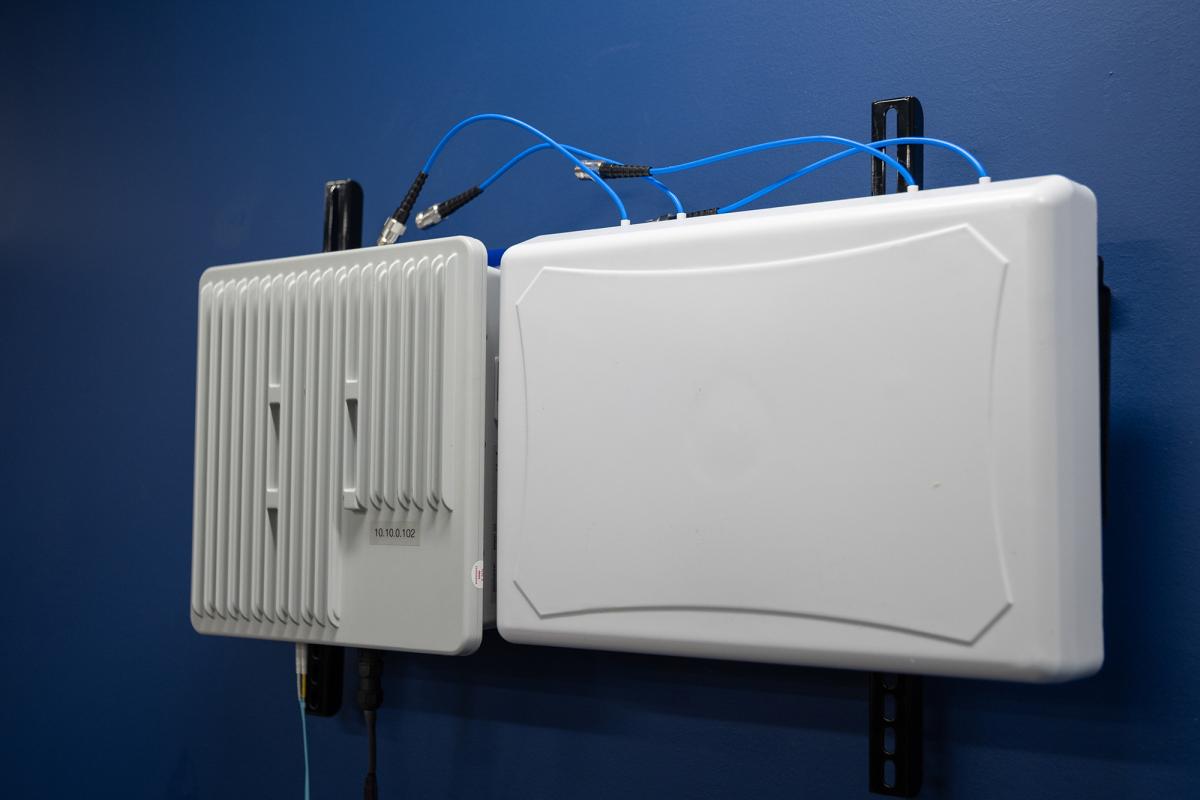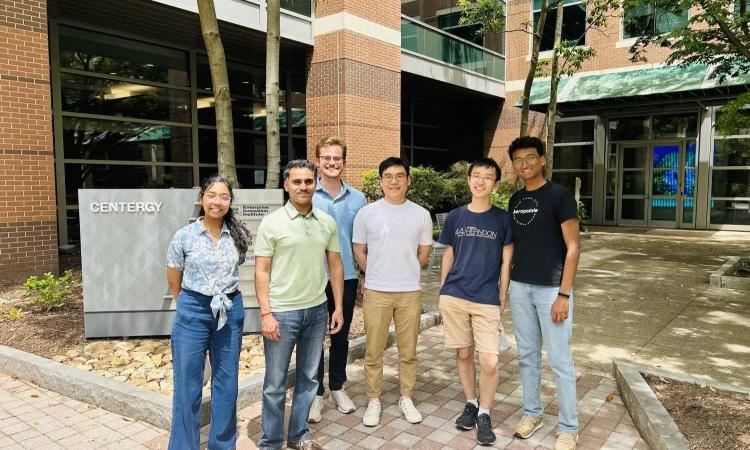The Center for Wireless Intelligence establishes Georgia Tech as a hub for wireless innovation, powered by a top-tier testbed spanning multiple sites and deep cross-sector collaboration.

The Center for Wireless Intelligence leadership includes Jeffrey Sitterle (GTRI), Sriram Vishwanath (ECE), Karthikeyan Sundaresan (ECE), and Faramarz Fekri (ECE).
(text and background only visible when logged in)
Georgia Tech is scaling up its wireless research efforts with the launch of the Center for Wireless Intelligence (CWI).
Based in the School of Electrical and Computer Engineering (ECE) and closely aligned with the Georgia Tech Research Institute (GTRI), the center will advance next-generation wireless technologies — collectively known as FutureG — to position Georgia Tech as a national leader in both commercial and defense wireless innovation.
“Wireless systems form the backbone of modern infrastructure, powering everything from global connectivity to everyday digital services,” said Faramarz Fekri, co-director and founding co-chair of CWI and ECE professor. “At Georgia Tech, we are committed to ensuring that the State of Georgia—and the nation—remain at the forefront as wireless demand and impact continue to grow.”
The next generation of connectivity is rapidly evolving from a means of communication into an intelligent, adaptive ecosystem, according to Fekri.
Artificial intelligence (AI)-powered networks embed learning, sensing, and decision-making directly into the network fabric, enabling systems to anticipate needs, allocate resources autonomously, and support mission-critical operations across sectors such as transportation, manufacturing, agriculture, defense, and healthcare.
“As we move toward FutureG, wireless connectivity will underpin a shift from connected devices to connected intelligence—where entities continuously learn, collaborate, and act across a deeply intertwined cyber-physical world,” Fekri said. “At CWI, our research is focused on realizing this vision: creating networks that not only connect, but also think, adapt, and enable intelligent, resilient, and autonomous systems across society.”
(text and background only visible when logged in)

Collaborative research in the CWI aims to advance wireless systems for defense and commercial applications, creating secure pathways to commercialization and strengthening domestic supply chains.
(text and background only visible when logged in)
What is FutureG?
FutureG refers to the evolution of wireless systems beyond fifth generation (5G) and sixth generation (6G) wireless technology.
While 5G has brought faster speeds and lower latency (better performance) to mobile networks and 6G is expected to push those capabilities even further, FutureG looks ahead to a more integrated approach. It combines wireless communication with AI, edge computing, and sensing technologies to support applications that require real-time responsiveness, high reliability, and autonomous operation.
“We’re entering an era where wireless systems can deliver massive data volumes at ultra low latencies,” said Karthikeyan Sundaresan, co-director and founding co-chair of CWI and ECE professor. “To fully realize that potential, we need infrastructure that is intelligent, self-learning, flexible, and capable of performing reliably in all settings, from cities, factories and enterprises to rural areas and contested environments.”
The FutureG-powered world will operate as intelligent ecosystems, where vehicles (terrestrial, aerial and space), infrastructure, and devices communicate and adapt seamlessly without human-in-the-loop to improve safety, efficiency, and quality of life, according to Sundaresan.
“It’s not just about faster connections,” he said. “It’s about building autonomous networks that can think, adapt, and support our societal needs as they evolve. CWI will be a pivotal platform in enabling the cross-cutting and use-inspired research needed to realize this vision and deliver real-world impact.”
A Testbed Built for the Future
A cornerstone of CWI is its 6G Integrated Sensing and Communication Testbed, which will span multiple cell sites across Georgia Tech’s campus and beyond. The testbed is one of few in the country that will combine sub-6 GHz and millimeter wave spectrum with edge computing and AI capabilities in a live urban environment.
“When fully deployed, this testbed will stand as one of the nation’s most expansive and sophisticated wireless research platforms,” said Sriram Vishwanath, founding co-chair of CWI and ECE professor. “It will give us an unparalleled ability to validate next-generation technologies in true real-world conditions, not just controlled laboratory settings.”
The testbed will support joint communication, sensing, and edge computing, which is considered important for autonomous systems and smart infrastructure. It is designed to be accessible to academic, industry, and government collaborators.
“This platform empowers collaborative research that informs national strategy and accelerates the pace of innovation,” said Vishwanath.
CWI’s testbed ecosystem will include three distinct environments, each tailored to different research and application domains:
- Campus Testbed (Georgia Tech) – A hybrid indoor/outdoor, urban testbed enabling experimentation in dense, real-world environments. Ideal for smart city applications and public infrastructure.
- Cobb County Testbed (GTRI) – A hybrid indoor/outdoor facility designed for defense, industrial, and enterprise use cases, including manufacturing, logistics, and secure communications.
- UAV Testbed (GTRI) – An outdoor testbed focused on unmanned aerial vehicle (UAV) and autonomous systems, supporting both commercial and defense applications.
“Combined, these platforms give us the flexibility to investigate an exceptionally broad set of capabilities,” said Vishwanath. “This unique setup firmly positions Georgia Tech at the forefront of innovation in wireless systems.”

At a specialized testing facility, Sitterle’s team advances UAV and autonomous systems as part of intelligent ecosystems that communicate and adapt autonomously.

A CWI testbed cell is displayed in the lab. Once cells are installed and activated across campus, the network will form one of the largest urban testbeds in the country.
Partnering with GTRI
CWI’s partnership with GTRI is central to its mission of advancing practical wireless innovation.
As Georgia Tech’s applied research arm, GTRI brings decades of experience in transitioning academic research into deployable technologies. It also operates multiple wireless-focused labs and projects, including work in spectrum sharing, secure communications, and advanced RF (radio frequency) systems.
“The collaboration between CWI and GTRI is essential,” said Jeffrey Sitterle, Regents’ Researcher, chief innovation officer for GTRI’s Information and Cyber Sciences Directorate, and CWI associate director of government engagement. “Together, we’re building a pipeline that moves ideas from the lab bench to the field, ensuring that U.S. wireless innovation remains both competitive and secure.”
This integrated approach allows CWI to leverage GTRI’s prototyping and systems integration capabilities, while aligning with real-world needs from government and industry.
The partnership also offers a potential model for how academic-affiliated centers can work alongside applied research institutions to accelerate innovation.
(text and background only visible when logged in)

Ph.D. students at the Center for Wireless Innovation advance next-generation wireless systems through hands-on research and access to cutting-edge infrastructure like the 6G Testbed.
(text and background only visible when logged in)
Closing the Gap in Domestic Wireless Manufacturing
Despite leading in wireless innovation, the United States continues to rely heavily on foreign sources for key wireless hardware components—including small cells, sensors, and core network infrastructure. This reliance presents challenges for supply chain security, scalability, and long-term technological independence.
CWI researchers are working to address this gap by supporting the full lifecycle of wireless technology development. Efforts span early-stage research, prototyping, testing, and pathways to commercialization and domestic production.
Workforce development also plays a critical role in this strategy. Through graduate-level education, applied research opportunities, and collaboration with industry, CWI will teach and train students to support domestic manufacturing and deployment of wireless technologies in strategic verticals.
“The future of wireless depends on our ability to produce the systems we rely on here at home,” said Sundaresan. “That means investing not only in advanced technologies and research, but also in the people who will build and maintain them, so we can continue pushing the boundaries even further.”
Learn more about CWI at wireless.research.gatech.edu.
(text and background only visible when logged in)
Related Content
Are Acoustic Waves the Future of IoT Sensors?
Professor Karthikeyan Sundaresan is exploring the use of acoustic waves to develop more efficient and scalable Internet of Things sensors, potentially transforming various applications from smart homes to vehicle synchronization and more.
(text and background only visible when logged in)
Researchers Break Boundaries to Spark Energy Innovation
At Georgia Tech, innovation flourishes where disciplines converge. By encouraging joint appointments, the Institute breaks down traditional academic silos and enables researchers to revolutionize the energy landscape.
(text and background only visible when logged in)

